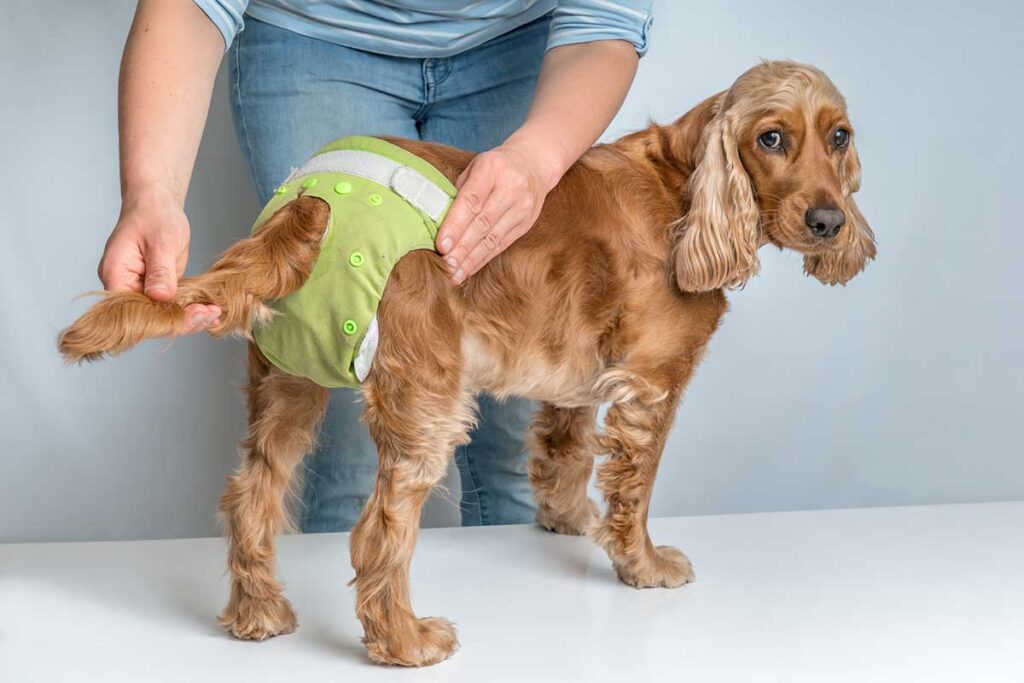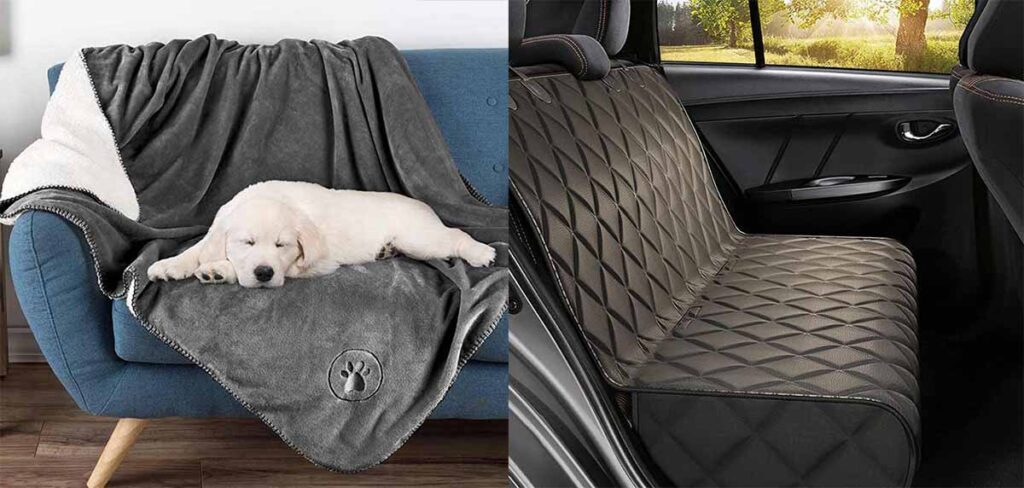
This article was updated on August 5th, 2022
Your situation:
✓ Your dog is a senior dog
✓ Your dog is aware that they are peeing inside the house
✓ Your dog is peeing more frequently than usual
(if this is not your situation, click here).
Your answers are an indication that conditions such as urinary tract infections (UTIs) or bladder issues. Let’s review the most likely conditions causing your senior dog to pee inside, and find out what you can do to help your dog (you should also consult with your veterinarian to perform a full physical exam).
Most Likely Reasons that Your Old Dog is Peeing Inside (Based on Your Answers)
If your dog is aware that they are peeing and they are peeing more frequently then they likely have some sort of urinary bladder issue such as cystitis or a urinary tract infection. Irritation within the bladder likely leads to a constant sensation of needing to urinate – they’re getting ‘caught short’.
Alternatively, they could also have doggy dementia – i.e. they have forgotten when they last urinated or drank so they do so more often.
1. Bladder Issues
Bladder issues such as cystitis and irritation within the bladder can lead to a constant sensation of needing to urinate. One major cause of bladder irritation is the formation of crystals within the urine which, if left untreated, can accumulate into bladder stones. Concentrated urine, infections and other chemical imbalances can lead to the formation of these crystals.
These crystals can act like sand within the bladder, causing abrasion to the sensitive bladder lining thus leading to bleeding and discomfort. In severe cases, bladder stones can block the urethra thus preventing urine from being able to pass, this is an emergency potentially life-threatening condition.
Another bladder issue that is of more relevance in older dogs, is bladder neoplasia, or bladder cancer. Tumors developing in the bladder wall will result in extreme irritation and will reduce the bladder’s ability to retain urine, thus creating the sensation of needing to urinate more frequently.
Symptoms include:
- Frequent urination
- Blood in urine
- Pain/excessive straining when urinating
- Visible ‘sand’ in the urine
- Lethargy
Diagnosis is achieved via analyzing the urine under a microscope for signs of crystals or abnormal cells, bladder x-rays and ultrasound scans of the bladder.
Treatment options:
The treatment of crystals within the urine will depend on the type of crystals present. Some crystals will dissolve once the urine becomes more dilute or if the pH is changed, whereas other crystals are insoluble once they have formed. For the former, changes in diet, rehydration and treatment of any concurrent infection can allow the crystals to dissolve. For the latter, the crystals or stones sometimes must be removed via surgery through a procedure known as a cystotomy. This involves opening the dog up to access the bladder in order to manually remove the stones.
Treatment of bladder cancer is via surgical removal (although this can be challenging) or chemotherapy. This will depend on the type of cancer present and how invasive it is.
2. Urinary Tract Infection
An infection within the bladder can lead to irritation and the constant sensation of needing to urinate. Any dog can get a urinary tract infection, although it’s most often seen in females. Urinary tract infections can usually be treated pretty easily, but you NEED to get the right antibiotic prescription from your vet. Sometimes a urine sample might need to be cultures in order to isolate the type of bacteria present.
Although UTIs are obviously uncomfortable (even painful) for your dog and inconvenient for everyone, they are generally not serious to begin with, unless there is a more sinister underlying cause.
Symptoms include:
- Frequent & urgent need to pee: he/she needs to ‘go’ a lot more often than normal… and that the urge to pee seems to be… well… suddenly extremely urgent! Plus, Fifi may only pass a few drops of urine even though she’s been dancing around in circles as if her bladder was bursting.
- Cloudy urine
- Traces of blood in urine
- Frequent licking at genitals or her sides
However, repeated UTI’s can also be caused by diabetes, kidney problems and bladder/kidney stones. If you leave the problem untreated it can become serious and affect other organs such as the kidneys. If you think that your dog (or pup) may have a bladder infection like this, get her examined by your vet right away.
3. Canine Cognitive Dysfunction
An older dog peeing in the house frequently, especially a ‘senior’ dog (and large or extra-large breeds can be considered seniors as early as seven years old), might be suffering from Canine Cognitive Dysfunction.
It’s also known as ‘Old Dog Syndrome’ and is very similar to human Alzheimers Disease or dementia. In this case, the physical cause for the unusual peeing isn’t located in the bladder/kidneys, but in Fido’s brain.
The changes that are going on there make him confused, and he might be urinating indoors because he’s ‘forgotten’ that he’s supposed to do his business in the yard. Sometimes old dogs with this condition seem to be unaware of their surroundings, or actions, and he might not even realize he’s peeing (or pooping) at the time, or afterwards.
There are lots of different symptoms of Canine Cognitive Dysfunction, and the frequent need to urinate is just one of them.
Symptoms:
- Frequent urination
- Sleep disruptions
- Loss of appetite
- Confusion
- Behavior changes
- Restlessness
- Shaking, trembling, panting
Although this all sounds worrying, there are things you and your veterinarian can do to help your senior dog if he does turn out to be experiencing old dog syndrome.
Sometimes these symptoms can come on very slowly and owners think it’s just that their pooch is getting old. But normal aging doesn’t generally make a dog upset, anxious, miserable or confused! Your vet can make a diagnosis and make sure Fido gets the right treatment. There are medical options available to improve the functioning of the brain. How well your dog responds to treatment can vary and they may always be a little more confused than usual, that’s where management and lifestyle changes come into play.
6 Ways To Help Manage Dog Incontinence – and Avoid Messes!
While you wait for your visit to the vet and experiment with treatment options to solve your dog’s incontinence, you can also do a few things to make life with a leaky dog easier for everyone. Sometimes, incontinence in dogs can’t be helped by medications/treatment and simply needs to be managed. In that situation, the focus is on products to make living with an incontinent dog easier:
1. Try Doggie Diapers: Doggie diapers will help protect your carpets, bedding and furniture from constantly being dripped on or flooded when your old dog is peeing in the house.

If Fifi only loses control when she’s sleeping, you can just put a diaper on her before it’s time for bed or when she’s taking a nap. If it’s a more constant dribble, then she may need to wear them for longer periods. View our favorite doggie diapers.
2. Be Ready for Dog Urine Clean-Up: Having the right urine odor and stain removal products at hand can make life a lot easier. Keep plenty of absorbent paper towels or old bath/hand towels in strategic places around your house for instant mop up. We have tried just about all of the most popular pet cleaning products: find the ones that have passed in-home testing in our list of favorite dog urine cleaning products.
3. Get a Waterproof Dog Bed: There are no totally waterproof beds, but our page about waterproof dog beds features those that are very good at repelling urine or have removable covers and waterproof liners.
4. Proof your House & Car with Waterproof Covers: If your old dog is regularly using your couch, bed, or car seats, consider waterproof sheets or rubber-backed sheets or blankets. View our recommended waterproof blankets. You can also buy a waterproof car seat cover for less than $40 on Amazon.

5. Place Doggy Potty Training Pads Strategically Around Your House: you can use disposable potty training pads (Amazon link) positioned under or next to your dog’s bed, or in strategic places around the house, to help make accidents easier to clean up. To help your old dog understand this new process, place a paper towel with a few drops of their urine over the new training pad.
6. Use Dog Urinary Health Supplements: natural supplements can help support healthy urinary tract function. They won’t stop incontinence, but they can help prevent it from getting worse as well as keep your dog’s bladder healthy.
In addition to vet-prescribed medications or procedures, a range of natural products are designed to help keep your dog’s urinary system healthy and functioning as well as it possibly can. There are many different options to choose from, including options from reputable, well-regulated manufacturers that we trust. View our recommendations for dog urinary health supplements or learn more about the best dog incontinence products.
How Do you Stop an Older Dog From Peeing Inside?
How you treat your old dog’s incontinence problems depends on what is causing the issue in the first place.
Depending on the cause, there are lots of effective remedies available for Fifi or Fido’s leaky plumbing issues, from medications and supplements, to surgery. Learn more about the best treatment options on our page about treatment options for old dog incontinence.
Learn about treatment options for old dog incontinence
Questions Your Vet May Ask You
A senior dog peeing in the house is often a symptom of a more serious condition. If your old dog is regularly peeing indoors, we recommend that you take him to your local veterinarian. You will want to be prepared to help your veterinarian diagnose the cause of your dog’s incontinence.
Questions Your Vet May Ask you: your veterinarian will first ask you several questions about the nature of your dog’s urinary issue, such as:
- how long has your dog been incontinent? is your dog generally well?
- how often is your dog peeing throughout the day? is your dog peeing more frequently now?
- is your dog straining to urinate (or is urine dribbling out)?
- is your dog drinking and urinating more than usual?
Bring a Urine Sample with You
your vet will thank you for it – ideally collected first thing in the morning as this will measure how well the kidneys are concentrating the urine. A urine sample can provide key insights into your dog’s health; by analyzing the urine for the presence of different components such as glucose, protein, blood cells and bacteria as well as testing the pH, your vet can get a really good idea for what might be causing the symptoms your dog is displaying.
Sometimes your vet may need to take a sterile urine sample directly from your dog’s bladder with a needle, especially if they are concerned about a urinary tract infection. While this sounds scary, most dogs tolerate it very well and sedation can be given if not.
Physical examination: Your vet will also perform a physical examination, assessing various body systems and looking for clues as to what might be causing the incontinence. However, there is only so much information your vet can acquire from the examination, and often further tests will be required.
Additional tests: In some cases, additional tests such as blood tests can be performed to help diagnose the condition. Key parameters can give an insight into how well the kidneys are functioning, white blood cells levels can help identify the presence of infection and hormone tests can help look for endocrine diseases that may be influencing the urinary system.
An ultrasound scan of your dog’s bladder and kidneys can identify possible structural changes that might be causing urinary symptoms such as incontinence. Your vet will look for abnormalities such as bladder stones or growths.
What You Should Do
We recommend that your consult with your vet for a full exam and bring a urine sample with you. For most of these conditions, including bladder issues and UTIs, your vet is likely going to be able to come up with a plan to help alleviate these symptoms.
It is also important that your vet rules out other serious conditions that could also cause your old dog’s peeing inside the house (such as diabetes or Cushing’s disease).
You can also go back to our main page about senior dogs peeing inside.
Important note: Please consult with your veterinarian to determine the correct diagnosis. There could also be other reasons causing your old dog to suddenly start peeing inside. It is important that your veterinarian performs a full medical exam of your dog to determine the correct diagnosis and treatment options.
Disclaimer: This website's content is not a substitute for veterinary care. Always consult with your veterinarian for healthcare decisions. Read More.



Be the first to comment